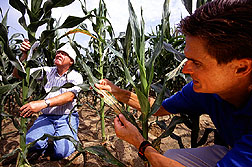This page has been archived and is being provided for reference purposes only. The page is no longer being updated, and therefore, links on the page may be invalid.
Grasses' Guardian Gene Found
By Don ComisJanuary 29, 2008
The world's grasses might not have survived long enough to evolve into the crops that feed the human race—as well as provide a growing share of the world's energy needs—had it not been for one gene that has protected them against a deadly fungal pathogen for more than 50 million years. These crops include wheat, corn, rice, rye, barley, sorghum and switchgrass.
Collaborative research by Steven Scofield, a research geneticist in the Agricultural Research Service (ARS) Crop Production and Pest Control Research Unit in West Lafayette, Ind., and Purdue University scientists Guri Johal and Michael Zanis has proven that this gene, HM1, has been present in all grasses since shortly after their origin and protects them from the fungus Cochliobolus carbonum Race 1 (CCR1).
Johal isolated the HM1 gene in 1992 from mutants of corn in which the HM1 genes were not functional. CCR1 is a devastating pathogen in these mutant corn lines, causing leaf blight, root and stalk rots, and ear mold. Fungal species in the genus Cochliobolus were responsible for three of the worst crop disease epidemics recorded in the 20th century, including the Southern corn leaf blight of 1970 that devastated around 15 percent of the U.S. corn crop. Johal also found that HM1 genes were present in other grass crops, raising the question: Does HM1 also protect these other plants from CCR1?
Scofield and ARS colleagues developed a virus-induced gene silencing system that switched off all HM1 genes in barley—causing it to become highly susceptible to CCR1. This proved that the HM1 gene provides CCR1 resistance in other grasses as well.
Thankfully, evolution generated the HM1 gene that provides highly effective protection against CCR1 for these crops. The understanding of the first known disease resistance gene that works across an entire taxonomic group holds promise for scientists seeking to develop similar resistance in other crop groups. Since mechanisms underlying broad disease resistance remain a mystery in plant biology, this finding represents a major step in understanding an important process in plant pathological research.
A paper on this research appears today in the Proceedings of the National Academy of Sciences.
ARS is the U.S. Department of Agriculture's chief scientific research agency.

